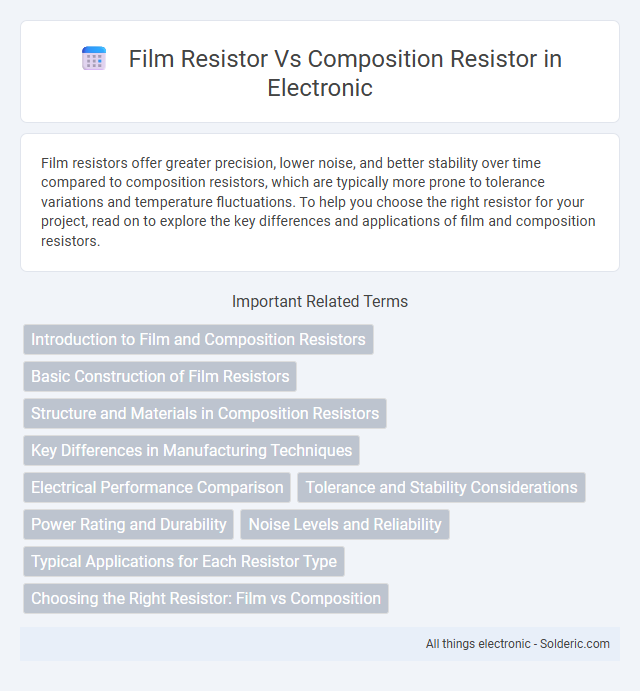Film resistors offer greater precision, lower noise, and better stability over time compared to composition resistors, which are typically more prone to tolerance variations and temperature fluctuations. To help you choose the right resistor for your project, read on to explore the key differences and applications of film and composition resistors.
Comparison Table
| Feature | Film Resistor | Composition Resistor |
|---|---|---|
| Material | Thin metal or metal-oxide film | Carbon or carbon-compound mixture |
| Precision | High, tolerance as low as +-1% | Lower, typically +-5% or worse |
| Stability | Excellent over time and temperature | Less stable, drifts with age and heat |
| Noise | Low noise | Higher noise |
| Power Rating | Typically up to 0.5W to 2W | Varies, often 0.125W to 1W |
| Temperature Coefficient | Low TCR (+-50 ppm/degC typical) | Higher TCR (+-200 ppm/degC or more) |
| Applications | Precision circuits, audio, instrumentation | General purpose, high pulse energy |
| Cost | Higher cost | Lower cost |
Introduction to Film and Composition Resistors
Film resistors feature a thin metallic or carbon film deposited on a ceramic substrate, offering precise resistance values and enhanced stability in electronic circuits. Composition resistors are made from a mixture of carbon particles and a binder, providing higher pulse handling but less accuracy and greater noise compared to film resistors. Understanding these differences helps you select the appropriate resistor type for optimal performance in your electronic designs.
Basic Construction of Film Resistors
Film resistors consist of a thin layer of metal or metal oxide deposited on an insulating ceramic substrate, offering precise resistance values and stability. Composition resistors are made from a mixture of conductive carbon particles and insulating binder materials molded into a cylindrical shape, providing higher power dissipation but less accuracy. The basic construction differences impact noise performance, temperature stability, and tolerance levels, with film resistors generally preferred for high-precision electronic circuits.
Structure and Materials in Composition Resistors
Composition resistors consist of a mixture of carbon particles and a binder, molded into a cylindrical or rectangular shape, providing a bulk material structure. Their granular carbon composition allows for higher energy absorption but results in lower precision and stability compared to film resistors. Understanding the structural differences helps you choose between the precise, thin-film resistor and the robust, heat-tolerant composition resistor.
Key Differences in Manufacturing Techniques
Film resistors are manufactured by depositing a thin layer of resistive material, such as metal oxide or carbon film, onto an insulating ceramic substrate using vapor deposition or sputtering techniques, resulting in precise resistance values and better stability. Composition resistors are produced by mixing powdered carbon or metal oxides with a binder, forming a resin-based mixture that is molded and baked, which leads to higher tolerance and less stability under temperature variations. The manufacturing process of film resistors allows for tighter resistance tolerance and improved noise performance compared to the bulk material mixture approach used in composition resistors.
Electrical Performance Comparison
Film resistors exhibit superior electrical performance compared to composition resistors, offering lower noise levels and higher stability across temperature variations. Film resistors maintain precise resistance values with minimal tolerance shifts over time, while composition resistors are prone to greater resistance drift and noise due to their heterogeneous material composition. The improved linearity and reduced inductance of film resistors make them ideal for high-precision and high-frequency electronic applications.
Tolerance and Stability Considerations
Film resistors offer tighter tolerance levels, typically ranging from +-0.1% to +-1%, ensuring precise resistance values essential for high-accuracy circuits. Composition resistors usually exhibit broader tolerances, often around +-5% to +-20%, which can lead to less predictable performance over time. Your designs demanding long-term stability and minimal resistance variation should favor film resistors due to their superior thermal stability and lower noise characteristics compared to composition types.
Power Rating and Durability
Film resistors offer higher power ratings, typically ranging from 0.25W to 2W, compared to composition resistors, which generally handle lower power around 0.25W or less. Their durability is superior due to stable materials that resist heat and moisture, resulting in longer life spans and consistent performance under stress. You can rely on film resistors for applications requiring better thermal stability and enhanced resistance to environmental factors.
Noise Levels and Reliability
Film resistors exhibit lower noise levels compared to composition resistors due to their stable metal or carbon film construction, which enhances signal clarity in sensitive circuits. Composition resistors tend to generate higher noise because of their heterogeneous carbon composition, leading to inconsistent electron flow and potential signal distortion. Your choice of resistor impacts the reliability of your electronic application, with film resistors offering superior stability and longevity under varying environmental conditions.
Typical Applications for Each Resistor Type
Film resistors are commonly used in precision electronic circuits such as audio equipment, instrumentation, and medical devices due to their stability, low noise, and tight tolerance. Composition resistors are typically found in applications requiring high energy pulse handling, such as motor controls, power supplies, and surge protection circuits, where their ability to withstand high energy spikes is crucial. Your choice depends on whether accuracy or power dissipation is the priority in your specific electronic design.
Choosing the Right Resistor: Film vs Composition
Film resistors offer superior stability, lower noise, and tighter tolerance, making them ideal for precision electronic circuits, while composition resistors, known for their high pulse tolerance and ability to withstand high energy spikes, are better suited for applications requiring high surge resistance. Selecting the right resistor depends on the specific performance needs: film resistors minimize thermal drift and noise in audio or measurement devices, whereas composition resistors excel in power and pulse applications where durability is critical. Understanding the trade-offs between electrical stability and surge robustness ensures optimal component choice for reliability and circuit performance.
Film resistor vs composition resistor Infographic

 solderic.com
solderic.com